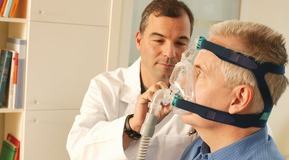

When you are asleep, the muscles in the upper airways (nose, mouth, throat and trachea) relax. If they relax too much, the airways can become constricted. This means that many people begin to snore. Sometimes it can even become difficult to breathe. If the airways are blocked completely, breathing is temporarily stopped (apnoea).
Obstructive sleep apnea is the most common symptom of sleep apnea, and means that breathing stops repeatedly during sleep. In some cases breathing can halt several hundred times every night.
Obstructive sleep apnea syndrome (OSAS) is due to episodes of airway obstruction during the night that produce symptoms during daytime due to lack of sleep. The apnea attacks lead to oxygen deficiency which in the long term can lead to an increased risk of high blood pressure, myocardial infarction and stroke.
Sleep apnea is a very common but still largely under-diagnosed condition. The typical OSAS patient is a greatly overweight man over the age of 40, but anyone can be affected.
The treatment includes weight reduction where justified, avoidance of alcohol and sleeping tablets and where appropriate use of what is known as a mandibular advancement splint. The next step in treatment is the use of a CPAP appliance that creates continuous overpressure in the airways so that they cannot collapse, or a bi-level device that forces air into the airways at different pressures depending on whether the patient breathes in or out.
Symptoms
The most common symptoms of sleep apnea are:
Snoring
Pauses in breathing during sleep
Abnormal tiredness during the day
Research shows that sleep apnea in the long term can lead to diseases such as high blood pressure, heart disease, stroke and diabetes. The patient also becomes more susceptible to stress.
Treatment
There are several ways of treating sleep apnea. The patient may, for example, try to improve his or her condition. The following simple lifestyle rules are recommended.
Have regular sleeping times
Introduce a routine you always follow when going to bed
Make sure that you have a comfortable bed
Air the bedroom every day
Avoid large meals in the evening and do not go to bed on an empty stomach either
Do not take a hot bath before going to bed
Do not fall asleep in front of the television
Do not drink alcoholic beverages before going to bed
The choice of treatment is governed by the severity of the disease, age, other diseases and any physical abnormalities in the nose and throat. Common treatments are
CPAP (Continuous Positive Airway Pressure)
Mandibular advancement device (in mild cases)
Surgical interventions (now increasingly avoided but may be necessary in the case of physical obstructions)
CPAP
The most common and most effective treatment for sleep apnea is CPAP (Continuous Positive Airway Pressure). CPAP blows ordinary room air into the patient's airways through a mask. The improvement in the patient's own quality of sleep and quality of life is often experienced quickly.
However, CPAP treatment requires a thorough sleep investigation.

